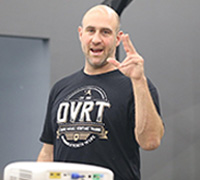The Good & Bad of Crawling Exercises
-Josh Henkin, CSCS
I remember it was one of the most challenging things we use to do for conditioning in high school. Off-season basketball was far worse than in-season, which is why we dreaded getting ready for the season. While the pre-season was much shorter, our coaches made it their mission to get us both mentally and physically ready for the upcoming season. That meant all sorts of things that seemed like medieval torture and at the time they probably were a bit. Looking back, if we really understood what and why we were doing some of this crazy stuff we could have not just become tired, we could have been much better! Especially when it comes to things like crawling exercises that just seemed simply evil at the time.

Crawling exercises have seen a resurgence in fitness for a number of reasons. For one, it is a moving plank and as you know planks have passed crunches for the most popular core exercises (which is a good thing if my dream of this being true is accurate). While most think that the way to progress in planks is to do them longer and longer. After all, more is better, isn’t it?
At a point, planks stop really being productive for your core strength. What you want to do is challenge your ability to maintain the plank while you add in motion. All of sudden the plank changes, movement creates instability and creates a huge stress to your plank. Sounds pretty reasonable, especially when you add in the fact we get hip and shoulder stability at the same time right?
Now, there are those that make crawling sound like a magical exercise. That since we perform crawling as kids, we should therefore see this as a neurological need to move correctly. However, this isn’t really true! Recently, crawling has been removed from the developmental stages of infants largely because, “Pediatricians have charts that say how fast children typically walk based on their age, but no such normative data exists for crawling. There are no clear, laboratory-based descriptions of the various types of crawling.”
In fact, historically, many groups of people didn’t have their kids for safety and sanitation reasons, “Infant crawling rarely happens in indigenous cultures, says Tracer, a biocultural anthropologist. He has documented that Au babies are carried by their mothers or siblings 86 percent of the time during the infants’ first 12 months.”
So, in review, crawling exercises can be a really good core, shoulder, and hip exercise, but saying we NEED to do it to restore some type of neurological function from when we were infants. The science doesn’t really show that to be true.
Even though crawling exercises are a great exercise, unfortunately people jump into WAY too fast, before really establishing a better foundation. That is where something like our Bird Dog progressions can really help understand the purpose of crawling exercises in alignment, tension, and building strength.
Physical therapist, Dan Swinscoe shows some key elements of the bird dog with the Ultimate Sandbag.
Physical therapist, Jessica Bento, helps me break down the bird dog cues and progressions even more!
Crawling exercises give us a more dynamic plank as one benefit, the other is the time under tension that your shoulders, hips, and core all get. In today’s fitness world, fast movements to get your heart rate up are all the rage. Unfortunately, one BIG thing we end up missing is time under tension.
Why is this a bad thing? Many experts believe time under tension is a key component of not just building strength, but muscle as well. Here is the crazy part, we also assume that only fast movements get our heart rate up, but time after time we have found people’s heart rates jump into over time when they are placed in situations when their body is under high time under tension?
How does that work? Well, if we put muscles under time under tension then we are extending the time they have to work. When we move quickly, the time our muscles are under tension is much less. Something to think about for sure! Sadly people go WAY too fast on crawling drills especially when we add in our Ultimate Sandbag drags. They lose SO much benefit by going way too fast or being out of position.
When done as Jessica shows below these crawling exercises can develop incredible overall strength and serve as an important pushing movement for much of our functional training that will help achieve many fitness goals at once!
Josh Henkin

Josh is an international presenter and strength coach who has taught in over 13 countries worldwide and consulted with some of the top fitness and performance programs in the world. You can check out his DVRT online fitness educational certifications/courses HERE and get 30% off with code “pb30”